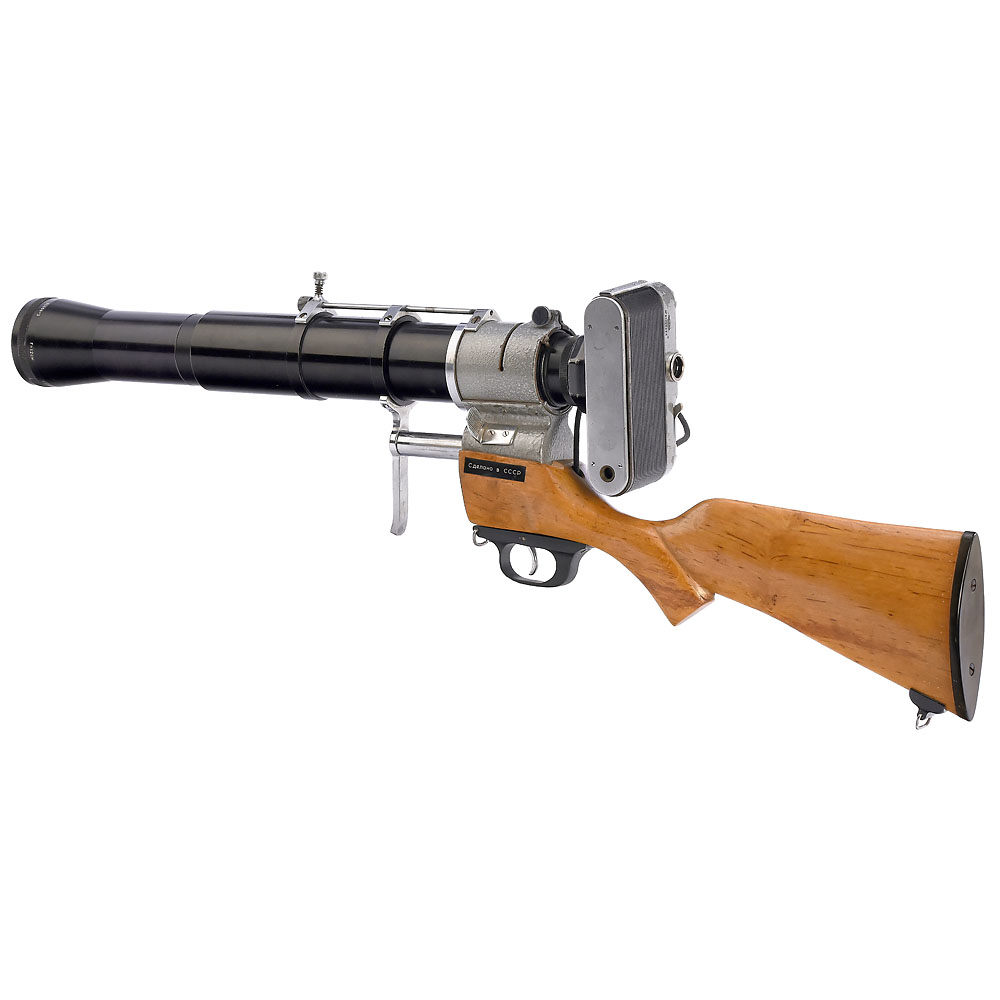KMZ Crystal Rifle Camera for the Hunt for Unknown Objects, c. 1963
Starting bid: € 3.000 | Estimate: € 5.000 – 8.000
KMZ, USSR. Crystal No. 61022994, SLR for 24 x 36 mm, with grey hammered paint effect, rifle mount in corresponding finish and an indirect zoom lens, shutter working. – Note: A scientific rifle camera for Unusual Flickering Objects that would otherwise appear blurred. The camera was presumably built as a prototype for scientists in Akademogorodok, to document insects or plants quickly, conveniently and undisturbed, as well as for researchers who need to focus objects far beyond infinity (optical cloaking) and are not disturbed by the inverted image in the reflex viewfinder. The camera is fitted with an indirect zoom lens, the negative element is fixed and there is no structural focusing option. The only movable part is the positive element, a Petzval type 2/12 cm no. 063270, which is far away from it. It is the only element that controls the lens by means of the stroke of the slide rod (51 mm stroke). Without stroke, the macro range is 1:1 at a distance of 65 cm from the front lens. With a stroke of 28 mm, infinity is reached with a focal length of approx. 500 mm. Then, structurally, there is a further stroke of up to 23 mm for considerable scope far beyond infinity, more than any known infrared index. Due to its design, the lens aperture is at its weakest at infinity; at close range the light intensity increases significantly due to the shortening of the focal length. The addition of an iris diaphragm is unnecessary. The image quality (checked with a strong magnifying optics in the film window) is of high color purity and sharpness.
KMZ-Kristall-Gewehrkamera für die Jagd auf das Unbekannte, um 1963
KMZ, UdSSR. Kristall No. 61022994, SLR für 24 x 36 mm, grauer Hammerschlaglack, Verschluß läuft, mit gleichfarbiger Gewehrhalterung. Die Optik ist eine indirekte Zoom-Optik. Das Negativglied ist fest montiert und ohne konstruktiv vorgesehene Fokussiermöglichkeit; beweglich ist nur in weitem Abstand davor das Positiv-Glied, ein Petzval-Typ 2/12 cm Nr. 063270. Es ist mittels des Hubs der Schiebestange (51 mm Hub) das einzige regelnde Element der Optik. Ohne Hub ist direkt der Makrobereich 1:1 bei 65 cm Abstand zur Frontlinse da, bei 28 mm Hub wird unendlich mit etwa 500 mm Brennweite erreicht. Dann folgt konstruktiv vorgesehen ein weiterer Hub von bis zu 23 mm für den erheblichen Spielraum weit über unendlich, mehr als jeder bekannte Infrarot-Index. Konstruktiv bedingt ist diese Optik bei unendlich am lichtschwächsten, im Nahbereich nimmt die Lichtstärke durch Brennweitenverkürzung stark zu. Eine Irisblende war unnötig, die Abbildungsqualität (mit einer starken Lupe im Filmfenster kontrolliert) ist von hoher Farbreinheit und Schärfe. Angenommen wird ein Optik-Prototyp für Wissenschaftler in Akademogorodok, um sowohl schnell und bequem und ungestört Insekten oder Pflanzen zu dokumentieren, als auch für Forscher, die bei Negativ-Luftlinsen der Atmosphäre für darin befindliche Objekte (optical cloaking) Fokussierungen weit über unendlich benötigen, und die das seitenverkehrt auf dem Kopf stehende Bild im Reflexsucher nicht stört. Eine wissenschaftliche Gewehrkamera für Ungewöhnliche Flimmernde Objekte, die sonst als hell leuchtender Fleck unscharf erscheinen. Ein einmaliges Gerät.



